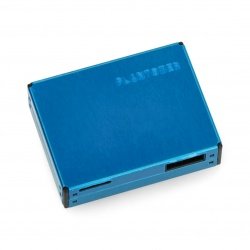Product description: Dust sensor / air cleanness sensor PM1.0 / PM2.5 / PM10 - PMS7003 - 3,3 V UART
Dust sensor allows you to monitor air pollution, measures the PM1.0, PM2.5, PM10. Equipped with a sensor that allows to detect particles with a diameter greater than 0.3 μm, such as cigarette smoke. The chip is powered by a voltage of 5, while the interface works with a voltage of 3.3 V, communicates through the UART interface.
The sensor has a blue protective film, originally the sensor is silver.
|
Product is compatible with Arduino and Raspberry Pi. Sample program for Arduino can be downloaded from here. Program for Micropython is available in GitHub repository. |
Connecting PMS7003 sensor
The sensor has ten pins, their description is shown in the table.
| Pin | Description |
|---|---|
| Pin 1 | VCC - 5V power supply. |
| Pin 2 | VCC - 5V power supply. |
| Pin 3 | GND - Ground. |
| Pin 4 | GND - Ground. |
| Pin 5 | Reset of the chip after low state is given - operates with 3.3 V. |
| Pin 6 | NC. |
| Pin 7 |
RX - UART receiver - operates with 3.3 V. |
| Pin 8 |
NC. |
| Pin 9 |
TX - UART transmitter - operates with 3.3 V. |
| Pin 10 |
SET - sleep after high state is given, works with 3.3 V. |
|
The device works with 3.3 V, to connect with a device working with higher voltage we recommend using voltage converter. Module has 1,27 mm pinout, we offer dedicated adapter for 2,54 mm pinout and adapter for JST 1,25 mm pinout. |
PMS7003 specification
- Supply voltage: 5 V
- Operating voltage: 3,3 V
- Current consumption: up to 100 mA
- Current consumption in idle state: up to 200 µA
- Sensitivity:
- 50 % for 0.3 μm
- 98 % at 0.5 μm and above
- Measuring range
- 0.3 µm to 1.0 µm
- 1.0 µm to 2.5 µm
- 2.5 µm to 10 µm
- Response time: less than 10 s
- Operating temperature: from -10 °C to 60 °C
- Board dimensions: 48 x 37 x 12 mm
- Weight: 27 g
Included
- Sensor PMS7003
PM1.0 / PM2.5 / PM10 particulate matter sensor - PMS7003 - 3.3 V UART
The dust sensor module allows you to track parameters determining the degree of cleanliness of the air in terms of PM1.0, PM2.5 and PM10 particles. The built-in measurement sensor enables the detection of particles with a diameter of 0.3 μm and above, such as components of tobacco smoke or exhaust fumes emitted by motor vehicle engines. The PMS7003 sensor requires a stabilized voltage supply of 5 V. Communication between the sensor and the microcontroller is via the UART interface, which operates at voltages with a logic level of 3.3 V.
Application of air quality sensor
The PMS7003 is a digital measurement sensor that measures the concentration of particulate matter in the air and converts this information into a digital form that is readable by the microcontroller receiving data from the sensor. The PM7003 sensor can be used in environmental applications such as airborne particulate measurement systems, as well as in advanced real-time air quality monitoring systems.
PMS7003 sensor principle of operation
The PMS7003 sensor operates on the principle of laser light emission and scattering. The laser beam produced by the sensor is used to illuminate the air to capture the particles in it. Based on the number of particles captured by the laser light, a processor embedded in the sensor approximates a curve representing changes in light scattering in the time domain. In the next step, the algorithm calculates the number of particles and their diameter per unit volume in the air, according to the Mie solution theory.
Sensor connection
The offered measurement module, based on the PMS7003 sensor, has a 10-pin IDC male connector. In order for the module to work with host devices (e.g. Arduino or Raspberry Pi based controllers), it is necessary to connect a special adapter, which has pins compliant with UART interface specification.
Such converters are also available in Botland shop, in 1.25mm and 1.27mm pinout versions.
Sensor communication with external devices
PMS7003 sensor measurement module uses UART interface for communication. This is one of the most commonly used communication standards in embedded systems.
UART uses four pins, i.e. power supply (VCC - supply voltage, in this case 3.3V and GND - supply ground) and communication lines for data exchange (RX - UART receiver and TX - UART transmitter). Thanks to this, the module can work with Arduino and Raspberry Pi.
Useful links |




















































































































































































































































































































































